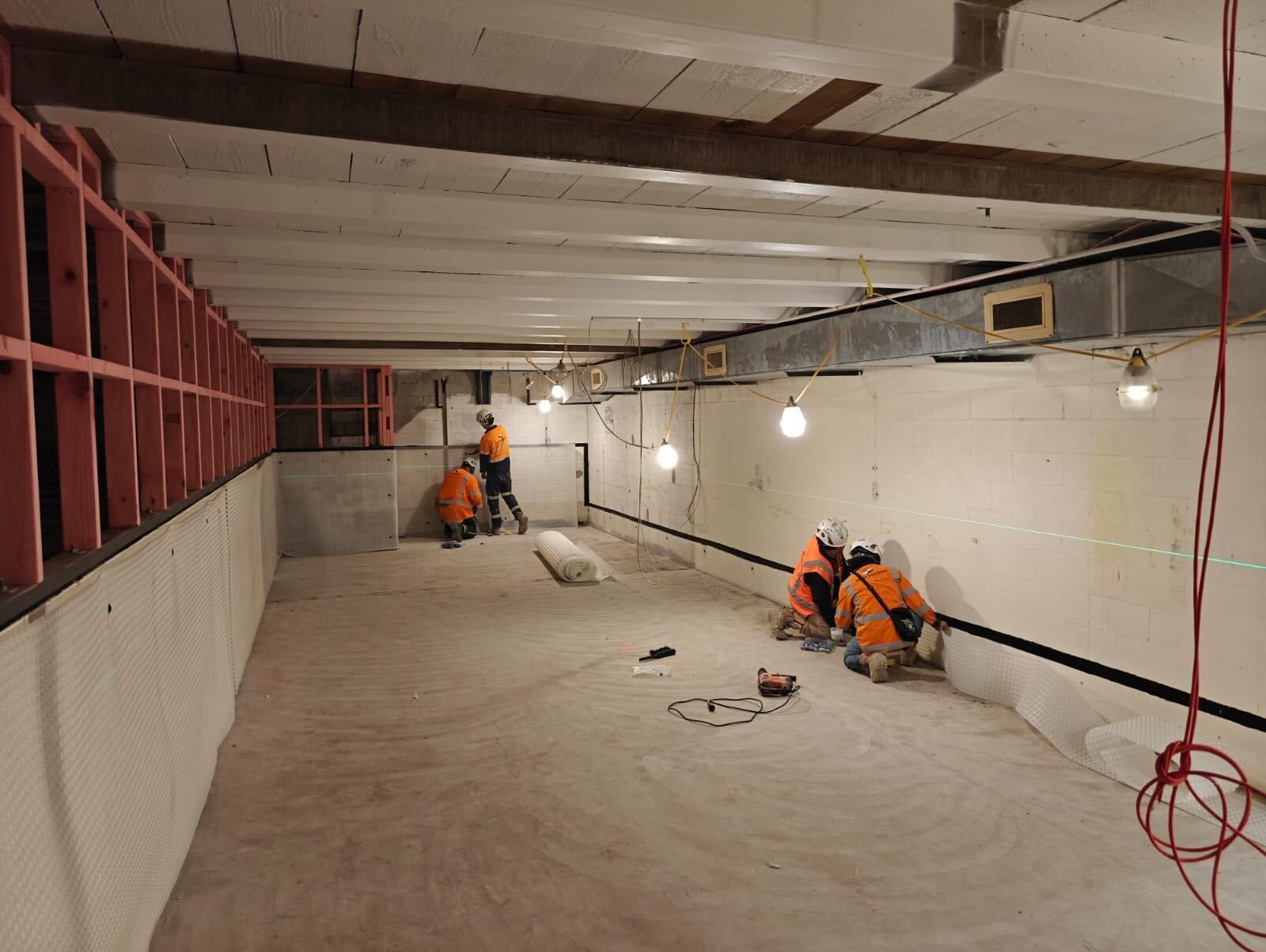By Steven van Rhoon, Director
While historically New Zealand has been slightly behind the times in terms of construction innovation, the rise in demand for warm roofs has been a welcome change.
These systems, designed and warranted for 20-year lifespans, represent a significant investment in our building infrastructure. However, their relatively recent adoption means we’re now entering uncharted territory with the first generation of these installations.
Recently, we’ve been noticing a concerning pattern.
Some warm roof issues and problems are beginning to surface, with many of these remaining hidden from public view.
Warm roofs can’t be treated like traditional roofs, they have vulnerabilities that need to be considered both at the design stage and construction and waterproofing stages.
Failure to do this can lead to significant problems that aren’t easy to detect until damage has been done by moisture to the roof.
What is a Warm Roof?
A warm roof design places the insulation layer above the structural substrate. This boosts energy efficiency by trapping heat inside and preventing condensation within the roof structure.
To avoid condensation on cold surfaces, a thin waterproof membrane called a vapour control layer is installed between the structural substrate and the insulation – which keeps the entire roof structure sealed and warm.
A waterproof membrane is then applied over the insulation and vapour control layer, acting as a protective barrier against the elements and ensuring the roof remains watertight.
Understanding Warm Roof Vulnerabilities
While warm roofs have better energy efficiency than traditional roofing systems, they aren’t without their vulnerabilities.
Warm roofs have an increased susceptibility to water ingress during construction and installation.
Unlike traditional roofs, where membranes are applied directly to concrete or plywood substrates, warm roofs contain multiple layers, including insulation, which creates more opportunities for water once entered to travel freely within the system.
Ultimately, this shouldn’t be a problem if installed and maintained correctly.
Convincing clients to invest in weather protection (shrink wrap), complete or staged, allowing the creation of daily night joints and temporary bunding, and installing temporary or permanent outlets/drainage to avoid standing water in the working areas will avoid water ingress during construction.
However, if the system is damaged during installation (or at a later stage) and water enters, it creates particularly challenging problems.
In traditional roofs, water damage tends to be localised and immediately visible, making it easier to identify and repair. In comparison, with warm roofs, water can travel freely underneath the membrane and throughout the insulation layers, potentially spreading far from the original entry point.
Water can then start to pool within the roof system without showing immediate signs of damage, creating its own environment and making it difficult to assess the extent of the problem.
A key difference between warm roofs and other roofing systems is how the various components react to temperature changes. This becomes particularly evident around drainage points, where there can be a stark contrast between how the warm section of the roof moves compared to colder sections near drains. These different thermal behaviours can lead to a phenomenon known as “rafting,” where the membrane develops wrinkles due to movement differences between sections.
These vulnerabilities can become even more pronounced when the roof experiences mechanical damage.
However, any good installer should be accurately aware of these potential issues. But, if they aren’t, then the damage to the system can be significant (and permanent).
While external forces can damage any roof, the consequences for warm roofs are often more severe. For instance, if the damage isn’t addressed promptly, water can enter the system and become trapped, leading to progressive deterioration of the system, potentially compromising the entire roof’s integrity.
This is why having strong Quality Assurance (QA) processes during the job and once it is completed is so critical – particularly since any damage or water being trapped in the roof will most likely happen during construction.
Industry Challenges
The industry faces several interconnected challenges, particularly in education and understanding.
Many applicators are attracted to warm roofing primarily for its financial opportunities, viewing the additional insulation work as a chance to increase revenue.
However, they often lack a crucial understanding of the underlying science, including thermal dynamics, material movement, and compatibility issues.
The responsibility also includes design teams. Architects and engineers alike need a comprehensive understanding of warm roofs to create effective designs, but this expertise isn’t universal.
While some consultants demonstrate thorough involvement and control in warm roof projects, this level of engagement varies significantly across the industry. Although some architects are showing increased interest in construction quality assurance, there remains substantial room for improvement in design team engagement and understanding.
The industry’s structural organisation presents additional challenges. There is no dedicated industry group for roofing professionals, and while a membrane group exists, it’s supplier-run with limited applicator involvement.
Applicators can become paying members but have minimal input into industry direction. This has led to growing recognition that better industry organisation is needed, either through integration with existing groups or the establishment of new ones. The lack of formal certification requirements compounds these issues – currently, anyone can become a waterproofer without formal qualifications.
For Sansom, we believe this highlights the urgent need for standardised training and certification processes.
Failures and Solutions
Even in countries where education around warm roof installations is more comprehensive – issues still arise, which means there have been solutions developed to manage moisture.
For example, in Europe, there’s technology similar to a dehumidifier that can extract moisture from warm roofs. The system works by creating a vent in the roof and using the device to remove moisture through ventilation.
While this technology exists, it hasn’t been adapted to New Zealand yet.
Currently in New Zealand, the main remedial solution involves creating airflow by cutting into the roof and installing vents, particularly at low points. While this can effectively deal with moisture in the upper zone, there’s no mechanical or monitoring system in place yet. This method, though not ideal – especially when the low point is in the middle of the building rather than at the eaves – is still more cost-effective than completely replacing the roof.
Recently, Sansom dealt with a case of severe flooding that had occurred just three months after a warm roof’s completion. Caused by a burst hot water pipe in the plant room, the situation was exacerbated by a seemingly minor issue – waste plastic blocking the drain.
The blockage caused water to build up significantly. Also, the building’s design featured a concrete nib that lacked internal membrane protection. As a result, water not only overflowed but also penetrated through the concrete structure beneath the roofing membrane, leading to extensive flooding throughout the roof system – and many of the 13 floors below!
Rather than completely replacing the roof, which would have been extremely costly, Sansom developed an alternative remedial solution.
Our solution involved collaboration between consultants, suppliers, and contractors. Together, we opened up areas, including the gutter, and installed temporary vents to allow the space to dry out.
These vents will be removed after two years, by which time the roof should be completely dry.
Sansom
Overall, we think the increase in warm roofs being built is a positive change, but this change needs to be managed.
With nearly five decades of experience in waterproofing buildings, Sansom has witnessed firsthand the devastating impact of water damage on New Zealand’s buildings.
Systemic issues in construction methodologies can escalate into nationwide problems, affecting thousands of buildings and billions in property value. We don’t want warm roofs to end up like this.
Our expertise in warm roof systems, combined with our historical perspective, places us in a unique position to advocate for industry-wide improvements. We believe that addressing potential vulnerabilities in warm roof installations now is crucial to preventing the emergence of widespread issues in the future.
As a company, with every new type of construction or waterproofing system that we adopt, we make sure our team understands how it works, is trained to a high standard, and that we have comprehensive QA in place to catch anything that needs to be to be rectified during the work.
We are specialists in waterproofing warm roofs, so if you’d like to chat about your next project – get in touch.




